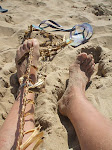In a bid to be environmentally friendly I went to Noordwolde in
Looking at the acres of new railway infrastructure construction as we hurtled through Northern France, Belgium and southern Netherlands I began to wonder why we are being persuaded that it is more environmentally friendly to cover the land with new railway lines when looking up, all I could see was empty blue sky from horizon to horizon marked by the occasional vapour trail from a solitary aircraft!
There is a scene in the wonderful animation by Sylvain Chaumet, Triplettes de Belleville, where the development around ‘Grandmas’ house has left the building that was once in the country jammed between a railway line, pylons, motorways and buildings with commuter trains now running right outside the upper floor windows. You can see a bit of it here . This vignette kept coming to mind as we screamed past bedrooms and gardens, places we usually like to think of as personal, private and tranquil havens.
It was the gardens that really got to me. Everywhere along these railway lines people had created little patches of verdant paradise with affectionately tended grass, topiary, flowers and exotic trees, as though they were trying to compensate for the hideous sight and sound of the railway line that they have to share their lives with.
Things improved once I got beyond Rotterdam Netherlands Zwolle
On my first evening stroll at twilight I saw a hare, only metres away. I had never seen a live hare before, I thought it was a dog with extra large ears!
The motive for my journey was a two day workshop to coincide with Urban Baskets which has been on show at the Nationaal Vlechtmuseum since July. The workshop was fully booked with 21 highly motivated and hard working students, including two men! I am always delighted to get men in my workshops and I like to have a lot of students mainly because it keeps me busy. More importantly though, I believe the students can learn as much from each other as from me, as everyone inevitably does something very different simply because they come with different materials and skills. Men often make bigger things than women which, for me, is another good reason to encourage them.
Whilst I am personally fascinated by these social histories I am even more concerned with trying to make sure that these skills are not lost for future generations, so it was a real pleasure for me to meet Esme Hoffman and to see her work.
There is little chance for anyone to learn this craft to the same degree now at Lichtenfels as the skeined work module of the course has been reduced to just 6 weeks, which for anyone who has ever done any will know that it is barely enough time to learn how to make skeins let alone a basket! Esme is now seeking to take this skill in new directions and will be exhibiting alongside contemporary Dutch designers in a major exhibition next year in Holland. I can’t wait to see what she does.
 |
| Esme in her workshop, where she also offers classes |
She is one of relatively few young people in Europe who have been taught how to do very fine skeined willow work by elderly master craftsmen in Lichtenfels spending three years of her four year course focussing just on skeined work. She is also possibly the only one who has decided now to make it her speciality.
 |
| Esmes work |












Hi,
ReplyDeleteI wanted to tell you I enjoyed your display in Noordwolde very much!
Frederike, from Holland
Thank you very much Frederike for taking the trouble to tell me this. I often feel that I make things in order to give something, preferably pleasurable,to other people, whether I know them or not. Consequently I am very happy if they enjoy what I do and even happier if they tell me so!
ReplyDeleteIt is always nice to hear that people like your work. Multiply every comment by 10, then you know how many people at least like your work ;-)
ReplyDeleteBut I think you too make your interesting work because you love to do it! I like your recyclework! As a comtemporary lacemaker (transparants) I try to use in my work valuable 'rubbish' as well.
greets, Frederike